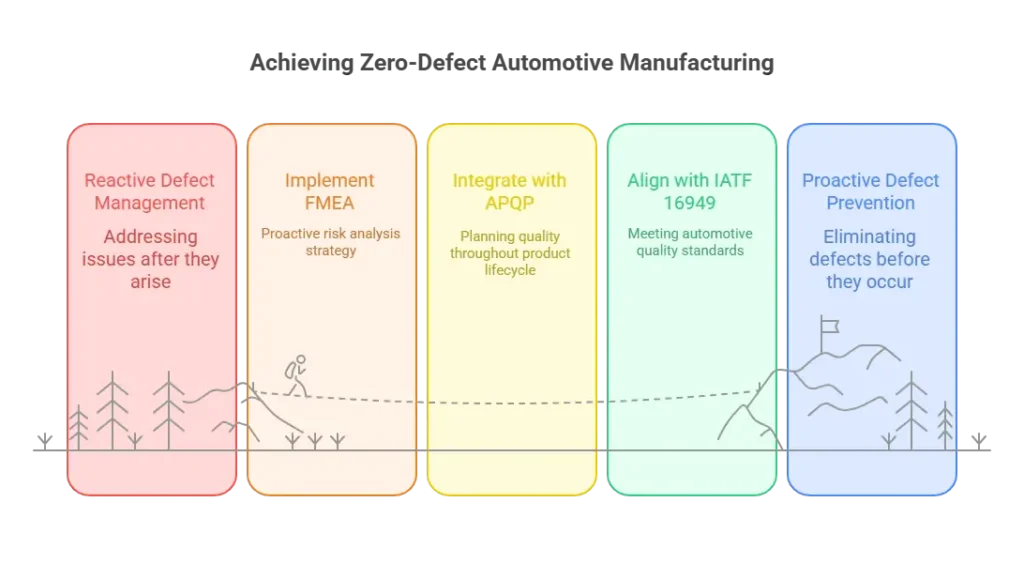In the automotive industry, providing a product that is safe, reliable, and compliant is not optional, it is mandatory.
Therefore FMEA (Failure Mode and Effects Analysis) becomes important and it plays a key role in both below topics,
- APQP (Advanced Product Quality Planning)
- IATF 16949:2016 (Quality Management System Standard for Automotive Production)
FMEA is not just a documentation, it is a risk analysis strategy. Risk-based tool to ensure “do it right the first time” and achieve zero-defect manufacturing.
This article explains how FMEA fits into APQP phases and aligns with IATF 16949 requirements.

What is APQP? #
Advanced Product Quality Planning (APQP) is a structured method used by the automotive industry to ensure product quality is built into the design and manufacturing process from concept to production.
It is divided into 5 key phases:
- Planning and Definition
- Product Design and Development
- Process Design and Development
- Product and Process Validation
- Feedback, Assessment & Corrective Action
FMEA is one of the Core Tools used in multiple APQP phases.
Role of FMEA in APQP #
FMEA is integrated throughout APQP. It is not just as a single activity, but as a continuous input-output loop across 5 stages of APQP.
Phase-wise FMEA Application:
| APQP Phase | FMEA Activity |
|---|---|
| Phase 1 – Planning | Define scope, team, timeline for FMEA (5Ts) |
| Phase 2 – Product Design | Perform DFMEA to assess design risk |
| Phase 3 – Process Design | Develop PFMEA to address process risks |
| Phase 4 – Product and Process Validation | Confirm actions from DFMEA/PFMEA are implemented |
| Phase 5 – Feedback | Update FMEA based on lessons learned, field failures, etc. |
Tip: APQP requires evidence of effective use of FMEA during customer audits and PPAP submissions.
What is IATF 16949? #
IATF 16949:2016 is the global QMS standard created specially for the automotive industry.
It is based on ISO 9001:2015 but includes additional automotive-specific requirements, which including:
- Risk management
- Product safety
- Defect prevention
- Process capability
- Customer-specific requirements
IATF 16949 focuses on Risk-based thinking: FMEA is the primary method for risk analysis.
IATF mandatorily says that:
❝ Use of quality core tools including FMEA, Control Plan, MSA, SPC, and PPAP where applicable. ❞
(Ref: IATF 16949:2016, Section 8.3.5.1)
Role of FMEA in IATF 16949 Compliance #
FMEA directly supports and contributed to several IATF clauses:
| IATF Clause | FMEA Contribution |
|---|---|
| 6.1 – Actions to Address Risks | FMEA identifies, evaluates, and prioritizes risks |
| 8.3.5.1 – Design & Development Outputs | DFMEA ensures functional safety and robust design |
| 8.5.1.1 – Control of Production Processes | PFMEA drives Control Plan creation |
| 10.2.5 – Problem Solving | Lessons from FMEA feed into corrective actions |
| 9.1.1.1 – Monitoring & Measurement | PFMEA defines critical characteristics for SPC |
Not having FMEAs, or keeping them outdated, is a common major non-conformance in IATF audits.
Example: DFMEA & PFMEA Use in Real Project using APQP and IATF framework #
Scenario: Launching a Seat Position Sensor Module
| Stage | FMEA Used | Purpose |
|---|---|---|
| Design Development | DFMEA | Identify failure modes like signal drift, connector corrosion, housing crack |
| Process Design | PFMEA | Address risks like incorrect placement, soldering defect, incorrect calibration |
| Process Validation | FMEA Actions Verified | Confirm controls like vision system, torque tool poka-yoke, training effectiveness |
Each FMEA output is connected to Control Plan, Work Instructions, and PPAP Submission.
FMEA is a Living Document #
As per both APQP and IATF 16949:
- FMEA must be updated regularly
- Revisit after design changes, customer complaints, new failure data, or audit findings
- Must show evidence of risk reduction through recommended actions
FMEA acts as the bridge between design, process, and validation in the automotive quality journey.
Example – Linking FMEA to Standards #
Imagine a bolting process on an automotive assembly line:
- DFMEA Analyze the risk of product characteristics – Torque requirement.
- PFMEA identifies: Risk of under-torqued bolts – Effect = Component loosens in vehicle.
- Control Plan defines: Torque monitoring system + operator checks.
- PPAP submission shows: FMEA + Control Plan – proving risk prevention.
- IATF 16949 compliance: It all shows and demonstrate risk-based approach & customer requirement fulfillment.
Summary Table: FMEA in APQP & IATF #
| Feature | APQP | IATF 16949 |
| Purpose | Plan quality from the start | Manage and reduce risk |
| FMEA Type | DFMEA, PFMEA | Both mandatory |
| Document Status | Active during all phases | Must be current during audits |
| Linked Tools | Control Plan, DVP&R, PPAP | MSA, SPC, CAPA |
Yes. FMEA is a core tool required by IATF 16949 (ref: clause 8.3.5.1).
Excel is allowed, but many Tier-1s prefer APIS IQ RM, Plato SCIO, or Knowlence TDC for traceability and multi-user collaboration.
DFMEA and PFMEA are required documents in the PPAP package. Incomplete or outdated FMEAs may result in PPAP rejection.



